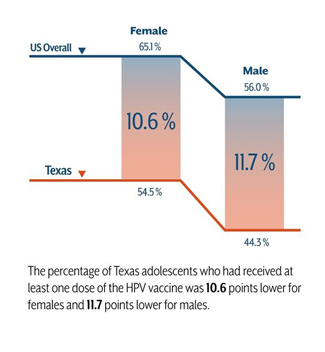 Surprise! The path to increasing human papillomavirus (HPV) vaccination rates lies in the patient-physician relationship ¾ in this case, it’s the parent-physician relationship ¾ new research found.
Surprise! The path to increasing human papillomavirus (HPV) vaccination rates lies in the patient-physician relationship ¾ in this case, it’s the parent-physician relationship ¾ new research found.
These findings should be welcome news in Texas, as another recent study showed the Lone Star State rapidly falling behind the rest of the country in vaccinating young people against HPV.

The vaccine protects against seven strains of HPV that can cause genital warts and several cancers, including cervical, throat, and penile. It is recommended for 11- and 12-year-old girls and boys, though older teens and young adults can get immunized, too. (See the current recommended HPV vaccine schedule.)
“More and more evidence is accumulating that successful HPV vaccine provision is all about effective communication ¾ how you recommend the vaccine and how you respond to hesitancy about the vaccine,” said Keller pediatrician Jason Terk, MD, who has been leading a project on HPV vaccine communication within the Cook Children’s Health Care System.
A team from the University of Colorado Denver School of Medicine says that training physicians in using a presumptive communication style and motivational interviewing strategies led to their patients having significantly higher odds of beginning and completing the HPV immunization series. Their results were published last week in JAMA Pediatrics.
Giving physicians a library of HPV fact sheets to use with patients also led to significant results, researchers wrote. Other potential interventions ¾ a tailored parent education website, a set of HPV-related disease images, and an HPV vaccine decision aid ¾ were not as effective, the study says.
The researchers trained participating physicians to begin the interaction with patients’ parents using presumptive communication. That means matter-of-factly including HPV in the list of vaccines for which the child is due on that visit and stating they will give the shot during the visit. This part of the study built on a successful 2016 North Carolina experiment using presumptive communication when talking to parents about the HPV vaccine.
For parents who hesitated, the physicians were taught to use motivational interviewing strategies. Motivational interviewing is most widely known for its use in drug abuse counseling. But it has been found to be appropriate when physicians are trying to convince their patients to adopt other behavior changes, including eating healthier, stopping smoking, and adhering to medication schedules. The approach relies heavily on the use of open-ended questions, not directive statements, as the physician tries to strengthen the patient’s own motivation and commitment to behavior change.
Spurred by the state’s low HPV immunization rates, the Texas Medical Association’s HPV Working Group encourages Texas physicians to review and use best practices for talking to parents about the vaccine. They particularly recommend the Centers for Disease Control and Prevention’s tip sheet, “Talking to Parents About HPV Vaccine.”
That tip sheet also starts with presumptive communication.
"Recommend HPV vaccination in the same way and on the same day as all adolescent vaccines,” it says. “You can say, ‘Now that your son is 11, he is due for vaccinations today to help protect him from meningitis, HPV cancers, and pertussis.’ Remind parents of the follow-up shots their child will need and ask them to make appointments before they leave.”
According to a December 2017 report by The University of Texas System Office of Health Affairs, there was only a 0.5-percentage-point difference between the national HPV vaccination rate of 34.6 percent and the state rate of 34.1 percent for young (13 to 17 years old) Texas males in 2013. Three years later, that gap had widened to 11.7 points: 56 percent nationally vs. 44.3 percent in Texas.
For young females in 2013, there was only a 1.1-percentage point difference between the national rate of 57.3 percent and the state rate of 56.2 percent. But by 2016, the national rate was 65.1 percent, while Texas’ rate was 54.5 percent, a 10.6-point gap.
For more information about the vaccine and tools you can put to use, see TMA’s online HPV Resource Center.